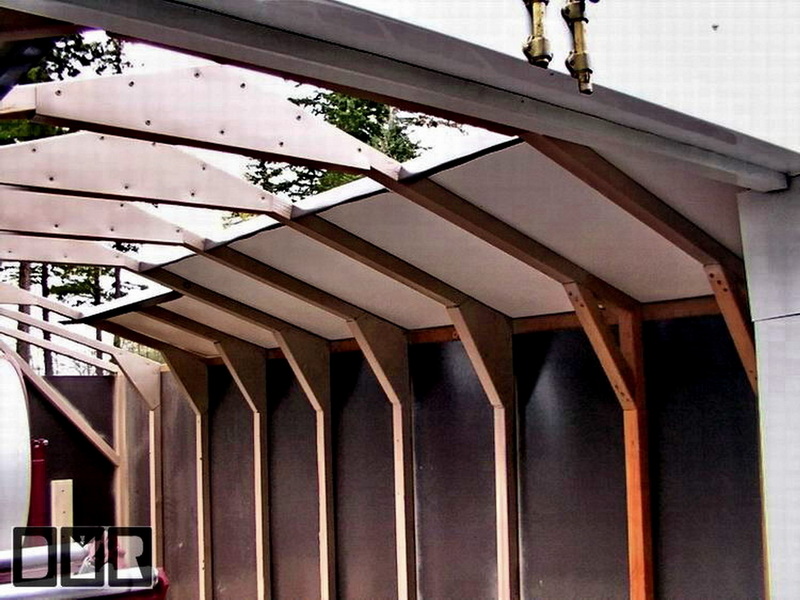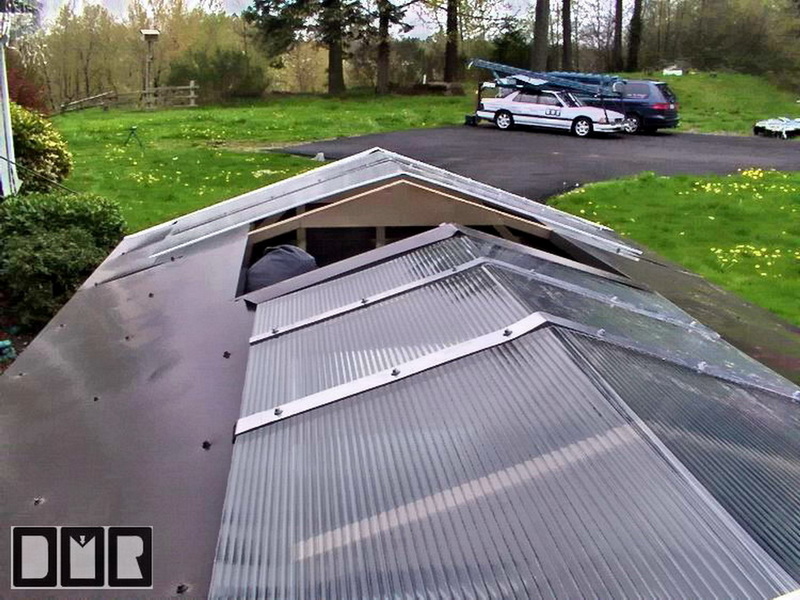
This clearly shows the 2x2 ribs. Many of which I
scabbed off of the old trailer. This is looking from behind with all
the ribs now built. I still had some cross braces to install on the
last two ribs. I had built the rear door frame. To minimize time off work, I
set the dimensions to use the old doors again.

Here below
is the first white pre-painted aluminum skin going on. I was impatient, and did not have all the ribs
built yet, but this will help hold the frame steady. You can see
there were no ribs past the wheel well. I left the front side open
to install the side door in front of the wheel well.

Since I wanted to make this upper shell wider than the old trailer, I
had to figure out a good sturdy way to build a
floor that extends outside of the steel trailer frame out to the outside
of the wheel wells, I was glad I did, as it made the interior
much more usable in moving around the machine.

The next side wall aluminum skin goes on over the ribs and under the
fascia board that I planned to mount the gutter onto. I had not yet cut the aluminum sheet
metal skin out over the wheels to fit around the wheel well.

Then there
is the next side wall aluminum skin on, shown from the inside rear. This
shows one cross brace before I cover it with an aluminum sheet metal
covers. I still have to finish closing off the wheel well on
the inside of the trailer, so it would not make a
horrible mess inside
the trailer on
wet days.

I
assembled this trailer frame with all screws and bolts. Absolutely no
nails. This is the fascia board I am installing to mount the gutter sample
onto. I would have loved to have more of an eave over hang, but the
trailer is already 7-feet wide w/o the gutter samples. Once I have the gutters on, it will
be over 7' 8" wide. The limit for a vehicle on the roads is 8 feet
wide. My work vehicle is only 6' 4" wide, so the trailer was sticking
about 9" out on each side of the car pulling it. The rear visibility
is rather compromised as it is, and my turning clearance is an issue.
I have to be very careful to give a wide birth, so as not to hit things
that my work car was clear of. Later I decided to just remove the gutter
samples, since very few new gutter clients would have a chance to see it
before the sale. It was cute, but
kind of pointless.

Here
is another picture that Tia took from an overhead view of me working on it. This was before I installed the many wood screws
with steel and rubber washers into the new white aluminum skins. Again,
I needed to pre-drilled the holes for those screws
to avoid any splitting or cracking of the small 2x2 boards. It was tricky
to line up the holes I drilled to be centered in the board
hidden behind the aluminum sheet metal.

The over head
clearance of the garage door frame was very close to the roof of the
trailer by just an inch without the roof panels on the trailer
shell. As soon as the weather cleared, I was able to move it
out of the work shop to install the roof panels. It would have been
easier to make a simple flat roof. Beside the cute dramatic look of a small
house, I hate the idea of rain water and subsequently mud puddeling on the roof panels.
It
also makes the removable roof panel much more stable on the freeway to have this
A-frame
roof. The removable panel is to be able to have a 400lb coil of new
sheet metal lowered onto the gutter machine spindle with a fork lift.

This
shows the back doors, that were off of the old trailer.
I was running out of
time and needed to put off building the new door that now swings up on a
pair of hydraulic supports. The size of the frame needed was just fine for the new
door, so luckily it was not a conflict.

This
is the side view, outside of the work shop. The roof panels are now ready to
go on.
It made me nervous to be off work for so
long with bills pilling up, so I was
in a little of a panic to get this ready to get back to my gutter work
jobs I had on my schedule.
Here
it is looking down into the trailer from the front. You can see that
all the ribs are built and braced. I also decided to spray paint the
wood to make it look more even.

You can also see the white sheet metal I
used to closed off
the inside of the wheel wells, to keep the splash of the rain water from
being flung into the trailer while being pulled on rainy days.

This
is another view from on top, looking forward.
The opening just above the coil is where I will be making
the removable panel to lower the gutter coils down into the gutter machine
spindle. The
coils need to loaded with a fork lift since a full coil is about 400
pounds. This gutter coil of pre-painted
aluminum sheet metal is 11 7/8" wide. This coil is only about 2/3
of a full coil, or else it
would be larger than the spool side walls.

This
shows the spool in the back of this picture, and the cradle in the
middle of the machine, and the cheap cradle I installed in the fore
front. Then I have the pocket for my 100' tape measure in yellow.
Again, the inside of the wheel wells are
closed off.

Another
view of the interior showing the side door on the left side, and the wheel
well aluminum inside cover, but still no roof panels yet. The
aluminum sheet metal I use come in sheets that are 4' X 10'. They are
painted white on one side and musket brown on the other side.
I chose to make this trailer with the white sides, with a brown
roof. So that means the ceiling is white.

Here
is the first roof panel to go on, leaving a space in the middle for the
skylight panels. The panels have a lot to do with the structural integrity
of the trailer shell.
I found this system to worked quite
well, using 2X2 boards and the
aluminum sheet metal screwed on with 1.5" screws that have steel and
rubber washers. Those screws are spaced about 6" apart. I made a
smaller trailer with an aluminum frame and covered with aluminum panels
and riveted them on with large 3/16" rivets, but the vibration of the
trailer in transpo would work those rivets loose

Here
is a shot of me screwing down the left roof panel, with Tia taking this
photo.
The back doors are open wide as you can see. If the sheet
metal was white on white instead, that would have been best
for function, so the light would reflect off the walls, making it
lighter inside. I could have made it all brown on the out
side, but I wanted a white look on the outside. I only made the roof
brown to look more like a house roof.















































